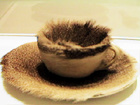 "The spirit of Dada is perhaps the best attitude for editors." So wrote Marvin Malone of the Wormwood Review.
"The spirit of Dada is perhaps the best attitude for editors." So wrote Marvin Malone of the Wormwood Review.The Wormwood Review seems to have started publishing in 1960, although I've found one note that suggests 1959.
Malone (born 1930) was its long-time editor, living (at some point during the long run) in Stockton, California. By 1990 an observer was noting 30 years of the mag. "If anyone wants to find out what is going on in today's avant-garde (yes, it lives), here is one of the first places to turn," says Bill Katz in the Library Journal (May 1, 1990). The communist-affiliated magazine Mainstream ran a symposium on little magazines in 1962 and for the December issue featured a statement by Malone. The role of the little mag in the USA, Malone opined, was "to persist in publication even though the format goes from print, to offset, to mimeograph," "to air the taboos" including "the stasis of culture in the USA at the pre World War II level," "to discomfit as much as possible the self-assured literary critics; to set up an active dissent against the easy success of X. J. Kennedy, Alan Dugan," and "to oppose the idea that 'black is black, white is white, and that gray is red'" (Mainstream, Dec. '62, pp. 41-42).
Well, it seems that actually Sandy Taylor founded Wormwood, along with Jim Scully and Morton Felix and that a little "later on" (how much later?) Taylor "ran it with Marvin Malone." Malone apparently took Wormwood to the west coast, although I have no info that it was founded elsewhere.
Malone was "a pharmacologist. He was a very well-known...researcher in pharmacology." (Obscure in the Shade of the Giants ed. Jerome Gold, Black Heron Press, 2001.) Malone died at 66 on 11/26/96.
Yes, Marvin Malone did Wormwood all these years on the side. Otherwise he served on editorial boards for the Journal of Natural Products, Economic Botany, and the International Journal of Pharmacognosy and was active as a member of the American Society of Pharmacology and Experimental Therapuetics. He was on the faculty of the University of the Pacific School of Pharmacy for many years.
Wormwood issued a broadside in 1963 that finally made an editorial statement (earlier issues had not): "The Wormwood Review is still non-beat, non-academic, and non-sewing circle and non-profit... not afraid of either wit or intelligence... published when sufficient good material has accumulated--this happens about four times a year."

 Is '60 the moment when the end of the end of the Old Left had been reached and the New Left began to emerge? Is it the final ascendancy, in certain scenes at least, of poetic postmodernity? Surely the publication of Donald Allen's The New American Poetry that year suggests this, but then again--once again--we look back on "New" here and see continuity. The rhetoric of the Kennedy-Nixon contest made much less of a dent than everyone (at the time as well as since) claimed, so one wonders why were such great claims made?
Is '60 the moment when the end of the end of the Old Left had been reached and the New Left began to emerge? Is it the final ascendancy, in certain scenes at least, of poetic postmodernity? Surely the publication of Donald Allen's The New American Poetry that year suggests this, but then again--once again--we look back on "New" here and see continuity. The rhetoric of the Kennedy-Nixon contest made much less of a dent than everyone (at the time as well as since) claimed, so one wonders why were such great claims made?  Had we come to expect "1960" to be truly ubiquitously modern in a way that the 1950s really were not--not quite? And what specifically does "modern" mean in the Kennedyesque talk then and now about the torch being passed to a new generation, etc.? The First Lady really meant "modernist" when Camelotians said "modern." What about the others across the new young cultural leadership? I've been surprised by how frequently the
Had we come to expect "1960" to be truly ubiquitously modern in a way that the 1950s really were not--not quite? And what specifically does "modern" mean in the Kennedyesque talk then and now about the torch being passed to a new generation, etc.? The First Lady really meant "modernist" when Camelotians said "modern." What about the others across the new young cultural leadership? I've been surprised by how frequently the  "Beat movement" was covered in 1960 in the mainstream press. I was expecting a fair measure but I've found tonnage. 1960 was the year when the figure of the beat was beginning to find acceptance, although still 80% of these stories are mocking, rebels-without-cause condescension. For anyone whose analysis made an impact nationally, do these antipolitical adolescents count as part of the "new young cultural leadership"? No, but rather than the two being opposites, they fall along a Continuum of the New American. Now that's a change for '60.
"Beat movement" was covered in 1960 in the mainstream press. I was expecting a fair measure but I've found tonnage. 1960 was the year when the figure of the beat was beginning to find acceptance, although still 80% of these stories are mocking, rebels-without-cause condescension. For anyone whose analysis made an impact nationally, do these antipolitical adolescents count as part of the "new young cultural leadership"? No, but rather than the two being opposites, they fall along a Continuum of the New American. Now that's a change for '60.







